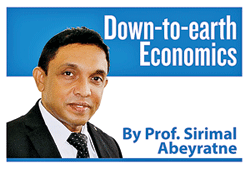Imported poverty
View(s):This alarming figure reflects a broader pattern of acute maternal and child malnutrition. Poor nutritional status in mothers often translates into undernourished children, with long-term consequences for physical growth, cognitive development, and overall wellbeing into adulthood.

Poverty is an acute problem in Sri Lanka.
At the root of this crisis is food insecurity—the lack of consistent access to sufficient, affordable, and nutritious food. For many families, this means worrying about the next meal, skipping meals, or going hungry due to financial constraints.
Sri Lanka’s recent economic crisis has sharply exacerbated these challenges. Poverty levels have surged, with the number of people living in poverty rising from around one million to an estimated six to seven million. This dramatic increase has deepened food insecurity and worsened malnutrition across vulnerable communities.
Cutting on meals
The Household Survey on the Impact of the Economic Crisis – 2023, conducted by the Department of Census and Statistics, reveals that over 99 per cent of households experienced rising food prices. More critically, 75 per cent reported altering their diets as a coping mechanism.
What do these dietary changes look like? The report highlights several strategies adopted by low-income households, including:
- Switching to cheaper, less preferred foods – often low in nutritional value
- Borrowing food or seeking help from relatives or community sources – not for better nutrition, but for basic survival
- Reducing the number of daily meals – a direct cut in food intake
- Sacrificing adult meals to prioritise children – a stark indicator of household-level triage
These adjustments reflect deep compromises in meal quality, quantity, and consistency—undermining both short-term health and long-term development outcomes of the poor.
Sri Lanka’s progress on the first two Sustainable Development Goals—No Poverty and Zero Hunger—is faltering. According to the Sustainable Development Council’s 2024 Progress Report, the country is on track to meet only two of the 17 SDGs by 2030, both related to energy and climate action. At current trajectory, poverty and hunger eradication remain distant goals.
Shocking culprit – the government
Sri Lanka’s food insecurity is not only the result of long-standing economic vulnerabilities and the recent crisis—it is also shaped by contradictory government policies.
While the government, with donor support, has launched various social protection programmes aimed at assisting millions of poor and vulnerable citizens, it has simultaneously pursued policies that keep domestic food prices elevated—often above regional averages.
 This duality is not new. For decades, price controls and protectionist measures have distorted food markets. The most recent report on the issue came a few weeks ago – the increase in the Special Commodity Levy (SCL) on imported potatoes and big onions. The SCL on potatoes has increased from Rs. 60 to Rs. 80 per kg and on big onions from Rs. 10 to Rs. 50 per kg with these changes taking effect on August 26, 2025.
This duality is not new. For decades, price controls and protectionist measures have distorted food markets. The most recent report on the issue came a few weeks ago – the increase in the Special Commodity Levy (SCL) on imported potatoes and big onions. The SCL on potatoes has increased from Rs. 60 to Rs. 80 per kg and on big onions from Rs. 10 to Rs. 50 per kg with these changes taking effect on August 26, 2025.
Such decisions affect a wide range of essential food items—including rice, the national staple. More nutritious options like dairy, meat, and fruit remain unaffordable for low-income households due to their exorbitant prices. Even locally produced items, such as poultry, are priced out of reach. This is largely due to the high cost of imported inputs, which are burdened by taxes, licensing requirements, and quota restrictions.
In effect, while social protection efforts aim to alleviate poverty, fiscal and trade policies continue to undermine food affordability—creating a systemic contradiction that deepens nutritional inequality.
Domestic producers
There is little surprise in the government’s recent moves—these are consistent with Sri Lanka’s long-standing protectionist approach to food policy. The stated rationale remains familiar: shielding local farmers from cheaper imports and nudging consumers toward domestically produced goods.
However, research into the outcomes of such import controls reveals a more troubling picture. These policies not only drive up food prices—disproportionately affecting low-income households—but also foster corruption, rent-seeking, and environmental harm.
Import licensing and quota allocations, managed by bureaucrats, have historically enabled opaque relationships between officials and importers. In sectors like poultry, where maize imports are essential, the cost of bribery and inefficiency is embedded in the price of everyday items like chicken and eggs.
The recent hike in the Special Commodity Levy on potatoes and onions has drawn sharp criticism. Beyond burdening consumers, the timing of the increase—after large consignments had already entered the country—has raised concerns about windfall profits for traders holding existing stocks. Farmer groups and civil society actors argue that such timing advantages a few, while the broader public pays the price.
In effect, while the rhetoric centres on protecting farmers, the reality is a complex web of policy contradictions, market distortions, and governance failures—all of which deepen food insecurity and erode public trust.
Undue profits
Sri Lanka’s pattern of enabling overnight profits for traders through abrupt policy shifts is not new. Whether intentional or by effect, successive governments—through a nexus of politicians, bureaucrats, and business interests—have repeatedly facilitated windfall gains across sectors, from motor vehicle imports to essential food commodities.
The recent economic crisis amplified this dynamic. For many domestic producers, it was a profit bonanza. Shielded by import controls and supply disruptions, they raised prices—often three to four times—placing immense pressure on already strained households.
This raises a critical question for advocates of protectionism: Did crisis-era import restrictions actually strengthen domestic production or enhance Sri Lanka’s long-term growth potential? Evidence suggests otherwise. Short-term gains for a few did not translate into broader industrial resilience or export competitiveness.
A senior public official once remarked to me, “We have to protect a few thousand family businesses in Sri Lanka, and it is the government policy that all 22 million people must pay for that.” That sentiment encapsulates the deeper structural problem: Sri Lanka’s reluctance to embrace an open, competitive economy. Instead of scaling up and integrating into global markets, many businesses remain inward-looking—content with protected margins rather than pursuing innovation or international growth.
This entrenched model not only stifles economic dynamism but also perpetuates inequality—where policy serves the few at the expense of the many.
Government revenue
One common justification for high import taxes is the need to boost government revenue—especially under Sri Lanka’s current IMF programme aimed at achieving fiscal consolidation. While fiscal discipline is essential, it should not come at the cost of overburdening consumers through a maze of commodity taxes: import duties, para-tariffs, excise levies, VAT, and more. In fact, sustainable fiscal reform demands the opposite—a fairer, more efficient tax structure.
Sri Lanka’s economic reality complicates this further. Nearly 60 per cent of employment and 90 per cent of businesses operate within the informal sector, which remains largely outside the reach of traditional tax instruments. Without a technology-enabled strategy to broaden and modernise the direct tax base, the country risks undermining its fiscal goals with an outdated and regressive system.
The World Bank’s 2025 “Public Finance Review: Towards a Balanced Fiscal Adjustment” underscores this concern. It finds that recent VAT reforms have contributed to rising poverty. While the bulk of VAT revenue comes from the top 60 per cent of households, poorer households bear a disproportionately higher burden relative to their income—deepening inequality and eroding public trust.
In short, fiscal consolidation must be smart, inclusive, and progressive. Relying on indirect taxes that disproportionately affect the poor is not only socially unjust—it is economically unsustainable.
Concluding remarks
When we account for the full spectrum of indirect taxes—VAT, excise duties, import tariffs, para-tariffs—and the added burden of import restrictions and associated corrupt practices, the cumulative effect is clear: these costs are ultimately borne by the consumer.
A country cannot sustainably increase tax revenue by suppressing aggregate demand and deepening poverty. The path forward must be the reverse: stimulating demand, empowering the poor to participate in the economy, and fostering growth through enhanced production and productivity in a competitive, transparent environment.
Only by shifting from extractive taxation to inclusive economic strategy can Sri Lanka unlock its true development potential.
(The writer is Emeritus Professor at the University of Colombo and Executive Director of the Centre for Poverty Analysis (CEPA) and can be reached at sirimal@econ.cmb.ac.lk and follow on Twitter @SirimalAshoka).
Hitad.lk has you covered with quality used or brand new cars for sale that are budget friendly yet reliable! Now is the time to sell your old ride for something more attractive to today's modern automotive market demands. Browse through our selection of affordable options now on Hitad.lk before deciding on what will work best for you!


